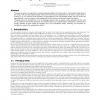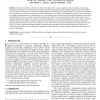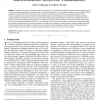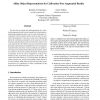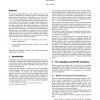102
click to vote
TVCG
1998
15 years 10 days ago
1998
This paper presents a new approach to rendering triangular algebraic free form surfaces. A hierarchical subdivision of the surface with associated tight bounding volumes provides ...
118
Voted
TVCG
1998
15 years 10 days ago
1998
—New challenges on vector field visualization emerge as time-dependent numerical simulations become ubiquitous in the field of computational fluid dynamics (CFD). To visualize da...
135
Voted
TVCG
1998
15 years 10 days ago
1998
—Recursive subdivision schemes have been extensively used in computer graphics, computer-aided geometric design, and scientific visualization for modeling smooth surfaces of arbi...
111
click to vote
TVCG
1998
15 years 10 days ago
1998
—Recently, multiresolution visualization methods have become an indispensable ingredient of real-time interactive postprocessing. The enormous databases, typically coming along w...
119
click to vote
TVCG
1998
15 years 10 days ago
1998
—This paper describes three new results for volume rendering algorithms utilizing splatting. First, an antialiasing extension to the basic splatting algorithm is introduced that ...
104
Voted
TVCG
1998
15 years 10 days ago
1998
—Numerical simulation of physical phenomena is now an accepted way of scientific inquiry. However, the field is still evolving, with a profusion of new solution and grid-generati...
108
Voted
TVCG
1998
15 years 10 days ago
1998
—Human figures have been animated using a variety of geometric models, including stick figures, polygonal models, and NURBS-based models with muscles, flexible skin, or clothing....
104
Voted
TVCG
1998
15 years 10 days ago
1998
We describe the design and implementation of a videobasedaugmentedreality system capableof overlayingthreedimensional graphical objects on live video of dynamic environments. The ...
112
click to vote
TVCG
1998
15 years 10 days ago
1998
—Volume navigation is the interactive exploration of volume data sets by “flying” the viewpoint through the data, producing a volume rendered view at each frame. We present a...
117
Voted
TVCG
1998
15 years 10 days ago
1998
Wavelet-based methods have proven their efficiency for the visualization at different levels of detail, progressive transmission, and compression of large data sets. The required...
